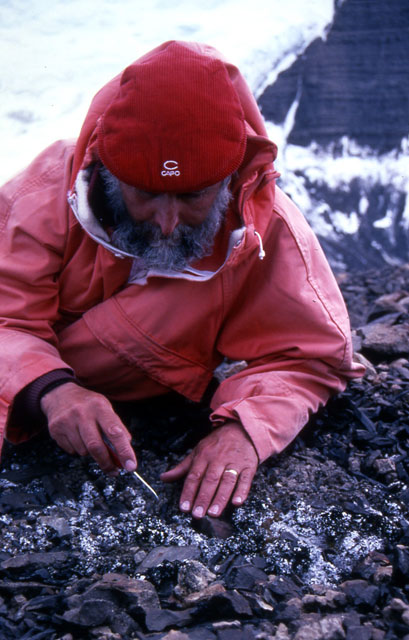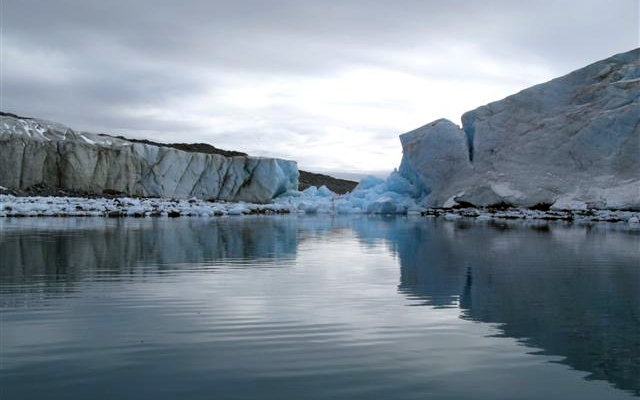|
IdentifiedMushrooms found near Palmer Station appear to be common but very poisonousPosted August 17, 2012
DNA analysis of some “little brown mushrooms” discovered on an island off the Antarctic Peninsula has found that the fruiting bodies of the fungi are extremely poisonous but relatively common, even in the extreme southern location in which they were found. The mushrooms were discovered growing earlier this year on Amsler Island, which is near the U.S. Antarctic Program’s Palmer Station She arranged for samples to be sent to Robert Blanchette 
Photo Courtesy: Ronald I. Lewis-Smith
Scientist Ronald I. Lewis Smith conducts fieldwork on Antarctica's largest island, Alexander Island.
Blanchette and researcher Benjamin Held The sequences obtained had a 100 percent match to sequences of Galerina autumnalis, according to Blanchette. Another name for the fungus is Galerina marginata. “The taxonomy of this group is not well studied, and some taxonomists recognize separate species. But molecular studies of these species suggest that they are all similar,” he said. “I am very happy that no one decided to eat these little brown mushrooms. This is a very poisonous mushroom when grown in temperate areas and contains amatoxins, which can cause death if eaten.” Blanchette said DNA sequencing also came up with a match to Galerina pseudomycenopsis. Forty years ago, mushrooms from the South Orkney Islands, off the northern tip of the Antarctic Peninsula, were also identified as belonging to the genus Galerina. Those mushrooms earned status as a new species, Galerina antarctica. “This identification was based on morphological characteristics and location,” Blanchette said. “There are no sequences of this species available to use for comparison so it is not known if this is truly a separate species.” There are about 20 species of macro-fungi mushrooms that have been reported to exist in the Antarctic. In addition, there are about 100 species of mosses, 25 species of liverworts and upwards of 400 species of lichen. Galerina marginata’s temperate cousin is a wood-rotting fungus that grows predominately on decaying conifer wood. 
Photo Credit: Rebecca Shoop/Antarctic Photo Library
Amsler Island, where the mushrooms were found, is glimpsed behind a collapsed snow bridge.
“This fungus has been found on wood, but its very wide distribution range suggests it is a generalist for what it can colonize and degrade,” Blanchette noted. “It apparently can live on many different substrates such as wood, moss or other types of organic materials.” Mushrooms are really quite common throughout the Antarctic Peninsula region to about 68 degrees south latitude, appearing especially in late summer, according to Ronald I. Lewis-Smith, who worked for the British Antarctic Survey Lewis-Smith said he frequently encountered mushrooms, particularly among moist carpets of moss. He said it would be premature and speculative to assume such sightings are related to climate change, but more likely to a “good growing season.” “Until there is a spate of previously unrecorded species being reported, or any being found on continental Antarctica, it would be unscientific to speculate,” he said. “However, it is a completely different story with microfungi [such as molds and mildews], as small increases in the thermal regime may well stimulate a host of new occurrences, particularly with ever-increasing anthropogenic introductions — notably in the vicinity of scientific stations and field research sites.” Blanchette explained that the main fruiting body of a fungus like the little brown mushrooms exists as microscopic filaments in dead moss tissue. The caps and stalks that most people identify as mushrooms may not appear annually, he said. Lewis-Smith said that in 1986, while working at the Australian Antarctic Division’s Casey Station “So, this proved the existence of macro-fungi, as mycelium amongst moss, in continental Antarctica, although the fruiting bodies [mushroom cap] have never been recorded in the field,” Lewis-Smith said. “This is probably because conditions [such as] temperature, moisture, etc., for their formation rarely, if ever, occur — but clearly could if the climate ameliorates in such coastal continental regions. “As far as I am aware, this is the first and only record of a mushroom from continental Antarctica,” he added. Blanchette said he would add the sequence from the Galerina specimen to GenBank “Although this fungus may not produce mushroom fruiting bodies regularly, it likely has lived a long life as mycelium and a decomposer of moss biomass, not only where it was found, but also over a wide range of the Peninsula where mosses are growing,” Blanchette said. “This adds one more important decomposer from the Antarctic environment to the list of fungi that need more study.”
|



For USAP Participants |
For The Public |
For Researchers and EducatorsContact UsU.S. National Science FoundationOffice of Polar Programs Geosciences Directorate 2415 Eisenhower Avenue, Suite W7100 Alexandria, VA 22314 Sign up for the NSF Office of Polar Programs newsletter and events. Feedback Form |

.jpg)
